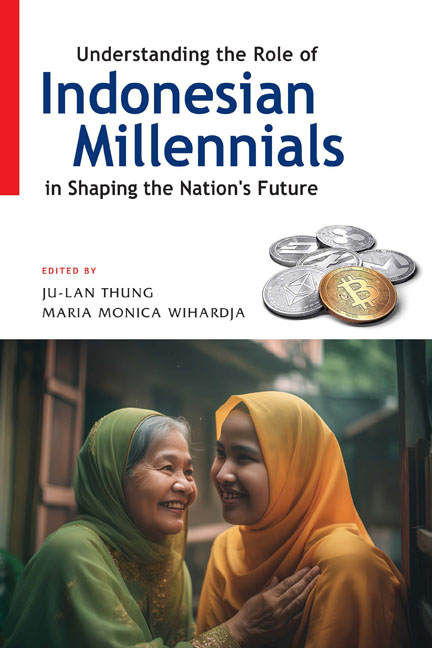Book contents
- Frontmatter
- Contents
- List of Figures
- List of Tables
- List of Annexes and Appendixes
- About the Contributors
- Introduction: Understanding the Role of Indonesian Millennials in Shaping a Nation’s Future
- 1 Generational Differences in Life Course Trajectories of Indonesians in Their Mid-twenties: Comparing Millennials and Older Cohorts
- 2 Millennials and Politics in Indonesia: 2019 and Beyond
- 3 Progressive Yet Powerless: The State of Indonesia’s Progressive Youth Organizations in the Post-Authoritarian Era
- 4 Indonesia’s Millennials and Gen Zs: Are They Financially (Il)literate?
- 5 Digital Competencies of the Millennial Generation in Micro, Small, and Medium Enterprises in West Bandung District
- 6 Millennial Muslims and “Haram Fatwas” on Cryptocurrency in Contemporary Indonesia
- 7 Youth and Religious Disaffiliation: A Study of Indonesian Millennials Learning Buddhism during Spiritual Disruption
- 8 Antagonism and Afterwards: Millennials in Indonesian Participatory Art after Reformasi
- 9 The NFT Phenomenon among Indonesia’s Millennial Artists
- Index
8 - Antagonism and Afterwards: Millennials in Indonesian Participatory Art after Reformasi
Published online by Cambridge University Press: 13 April 2024
- Frontmatter
- Contents
- List of Figures
- List of Tables
- List of Annexes and Appendixes
- About the Contributors
- Introduction: Understanding the Role of Indonesian Millennials in Shaping a Nation’s Future
- 1 Generational Differences in Life Course Trajectories of Indonesians in Their Mid-twenties: Comparing Millennials and Older Cohorts
- 2 Millennials and Politics in Indonesia: 2019 and Beyond
- 3 Progressive Yet Powerless: The State of Indonesia’s Progressive Youth Organizations in the Post-Authoritarian Era
- 4 Indonesia’s Millennials and Gen Zs: Are They Financially (Il)literate?
- 5 Digital Competencies of the Millennial Generation in Micro, Small, and Medium Enterprises in West Bandung District
- 6 Millennial Muslims and “Haram Fatwas” on Cryptocurrency in Contemporary Indonesia
- 7 Youth and Religious Disaffiliation: A Study of Indonesian Millennials Learning Buddhism during Spiritual Disruption
- 8 Antagonism and Afterwards: Millennials in Indonesian Participatory Art after Reformasi
- 9 The NFT Phenomenon among Indonesia’s Millennial Artists
- Index
Summary
Indonesian participatory art discourse has not caught up with the development of its practices over the last twenty years, especially those by millennial artists. The discourse also tends to be Eurocentric and fails to notice participatory phenomena in Indonesia rooted in the heteronomous spirit of Indonesian art and other factors. The forms of participatory art in Indonesia have begun to emerge concretely in the art practices of a few young artists’ work as an output of resistance or antagonism towards restrictive homogenization and paternalistic culture in art schools due to the depoliticization of art during the New Order era. These expressions manifested in the form of practices that violate conventional norms of art medium and invite the participation of marginalized populations affected by the New Order's centralistic pembangunan (development) policies. This chapter specifically examines the art practice of a Yogyakarta-based millennial artist, Anang Saptoto, as an example of post-Reformasi participatory art that differs from participatory art practices during the New Order era. As a millennial artist, Saptoto, whose participatory work responds to local agrarian problems, inherits the distinctive artistic spirit of Reformasi, which departs from the spirit of decentralization and localization of information technology to achieve the desired goals. Saptoto's participatory art practice is marked by a rupture from the antagonistic nature of young artists during the New Order era. The non-antagonistic temperament manifests in Saptoto's flexibility in encountering more complicated challenges: the neoliberal economy and education regime, and a commercialized and depoliticized art sphere, among others.
INTRODUCTION
This chapter discusses participatory art by millennials, which differs from that by previous generations. Millennial artists who practise participatory art cannot be subsumed under one rigid ideological category. They focus more on pursuing strategic solutions to achieve concrete results for marginalized communities. These artists who engage in activism unavoidably encounter more complicated challenges: the neoliberal economy and education regime, a commercialized and depoliticized art sphere, and regional feudalism, among others.
Participatory art substantially deconstructs the artist's role in creating art. Artists no longer monopolize the authorship of artwork; instead, they initiate cooperative authorship with the audience. The expanded role of the audience potentially cultivates their emancipation. This chapter aims to scrutinize the contemporary participatory art discourse and practice in Indonesia, especially by millennials. It argues that millennials develop participatory art practices while taking cues from an existing tradition that has emerged organically in Indonesia.
- Type
- Chapter
- Information
- Publisher: ISEAS–Yusof Ishak InstitutePrint publication year: 2024



